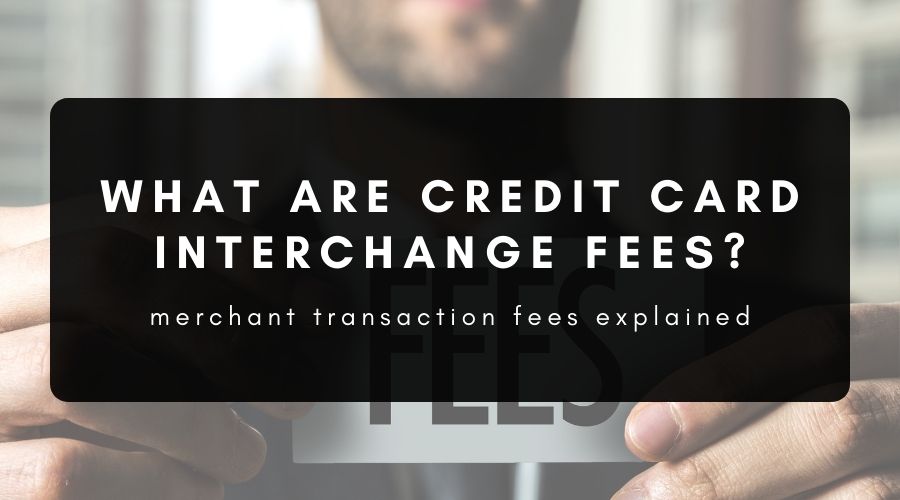
What Are Credit Card Interchange Fees?
Interchange fees are inevitable for any merchant who accepts credit and debit card transactions. Even if the fees don’t physically appear on your monthly statement, they’re usually wrapped up in your general transaction fees or subscription fees. This type of transaction fee is also known as an issuer’s reimbursement fee.
What Are Interchange Fees?
An interchange fee is a fee imposed on every credit and debit card transaction. Whereas most merchant-related fees are paid to the merchant provider, the interchange fee is paid specifically to the card-issuing bank for the purpose of covering transaction costs and offsetting the risk associated with processing credit card payments. In this regard, the transaction fee works as a form of insurance for the credit card issuer.
The interchange fee is actually a consolidation of about 300 different fees that are bundled together, and they compose approximately 70% to 90% of the total fees paid to banks by merchants. When you consider that credit card fraud in Europe accounted for more than Є1.5 billion in losses last year alone, it’s easy to see why credit card companies are passionate about mitigating their risk.
What Do Interchange Fees Cost?
Interchange fees are set by the credit card companies and adjusted twice a year. Visa and Mastercard, for example, update their rates in April and October. These rates are calculated based on a range of factors including current interest rates, authorisation costs, credit card fraud rates, and the cost of transferring funds.
Interchange fees don’t just vary based on the credit card company. They also vary based on other factors, including:
- Card type. Different types of cards incur different fees. Debit card payments carry lower interchange fees than credit card transactions because they’re lower-risk (since the funds are already available in the customer’s bank account). Interchange fees for pin-protected debit transactions are especially low since they rely on secure single-message networks to transmit customer data. Consider that interchange fees for credit cards average 1.8% while debit card interchange fees are as low as 0.3%. By contrast, rewards cards traditionally carry some of the highest interchange rates.
- Transaction type. Certain types of transactions cost more by virtue of their risk level and likelihood of fraud. For example, card-not-present transactions cost more than card-swiped transactions, foreign transactions cost more than domestic transactions (in some cases), and MOTO (Mail Order / Telephone Order) transactions cost more than online credit transactions.
- Business type. Different industries and merchant categories pay different interchange rates based on their size, average transaction value, and likelihood of fraudulent purchases. For example, some of the highest interchange fees apply to dining, fast food, lodging, telecommunications, and mail order businesses (about 3.5% on average). Supermarkets and universities have some of the lowest interchange fees (around 2% on average).
On the merchant side, you’ll generally pay about 2% of the total purchase amount on interchange fees. Unless your merchant statement itemises credit card fees, you’ll never even see this fee in most cases. The interchange fee is most commonly bundled into your standard merchant fees.
Sample Interchange Rates
To give you an idea of the types of interchange rates you might be accountable for, here are some sample interchange fee schedules for Visa and Mastercard (based on recent averages):
- Visa Debit. .8% (swiped) or 1.65% (keyed).
- Visa Credit Retail. 1.5% (swiped) or 1.8% (keyed).
- Visa Credit Retail Rewards Signature. 2.3% (swiped) or 2.7% (keyed).
- Mastercard Debit. 1.05% (swiped) or 1.5% (keyed).
- Mastercard Credit Retail. 1.6% (swiped) or 1.9% (keyed).
American Express, Discover, and other cards have their own interchange rates for electronic payments, most of which vary between .5% and 3%.
Are Interchange Rates Negotiable?
While large enterprise organisations can sometimes negotiate with credit card companies to secure lower interchange rates, this isn’t generally possible for your average business or merchant provider. Even if you have sky-high transaction volume, you’ll generally have to pay the current industry rate.
There are ways to lower your overall fees, however. Remember that the interchange rate is just one fee that’s commonly bundled with your other merchant fees (like transaction fees, network fees, batch fees, etc.). To get the best rate, look for a merchant provider that offers low subscription and transaction fees. You can often save money by bundling your merchant services and payment gateway.
Interchange plus pricing with markups is typically a more cost-effective pricing structure when compared to tiered and flat-rate pricing. With this pricing model, you pay the wholesale fee plus a fixed percentage of every transaction (usually 0.25% to 2.75%). You can sometimes secure an excellent rate by opting for a longer-term contract.
Making the Most of Credit Card Interchange Fees
It’s important to understand the various fees for merchants and how they factor into your cost of doing business. On the one hand, you want to offer as many payment options as possible to attract the greatest number of cardholders; on the other hand, some of those payment options can come with higher fees.
As long as you compare your options carefully and work with a merchant provider that offers the greatest total value for your investment, you can still maximise your profit margins and prevent interchange fees from decimating your bottom line—no matter what type of payment card your customers prefer.

